Ultragenyx Fights for Cures Amid Rising R&D Costs
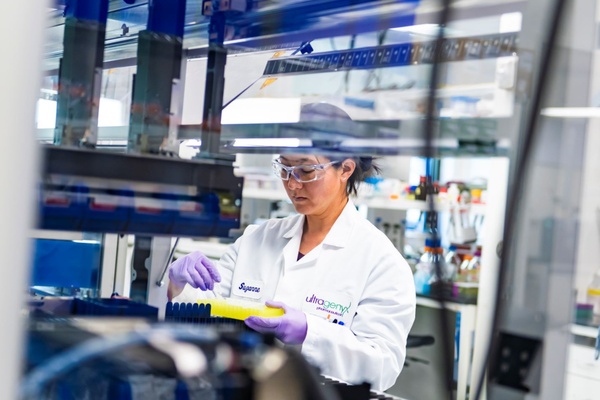
About 30 million people in the United States have a rare disease, according to the National Institutes of Health, which equates to about one in every 10 individuals. Approximately 95% of these rare diseases have no treatment at all—and Ultragenyx, a biopharmaceutical company focused on new and effective therapies for patients with rare and ultra-rare diseases, is working to change that.
- “In the aggregate, rare is not that rare,” said Ultragenyx Executive Director of Public Policy and Public Affairs Lisa Kahlman. “Half of those 30 million people are children. It’s a huge unmet medical need.”
Founded in 2010, Ultragenyx has four commercial products, with about 20 more in pre-clinical and clinical development. But a new change in tax policy poses a very real threat to Ultragenyx’s ability to develop as many treatments for rare diseases as possible.
The issue: Until a year ago, businesses could deduct 100% of their R&D expenses in the same year they incurred the expenses. Starting in 2022, however, a tax policy change requires businesses to spread their R&D deductions out over a period of five years, making it more expensive to invest in growth and innovation. For research-heavy companies like Ultragenyx, that change could divert funds intended for the development of therapies toward tax obligations.
- “Ultragenyx is different,” said Kahlman. “There are a lot of companies that do some work in rare diseases, but usually that’s only a fraction of what they do. We’re exclusively built to focus on rare and ultra-rare diseases, and that requires research.”
The impact: As a small, largely precommercial start-up company that focuses on research, Ultragenyx spends about 70% of its total operating expenses on R&D. In 2021, Ultragenyx spent approximately $497 million on R&D—nearly $150 million more than it earned in revenue.
- If the tax change stands, the company’s financial statement losses, which approximate decreases in the company’s cash reserves, will be adjusted for tax purposes to reflect significant taxable income, resulting in very large tax liabilities over a short period of years.
- This will occur during late stages of the company’s development programs just when costs escalate quickly. Altogether, money will be diverted to taxes and away from critical development programs at precisely the wrong time.
The human cost: If Ultragenyx and other research-heavy biotech companies that are focused on developing treatments for rare diseases must divert funds away from development and toward covering tax obligations, patients living with rare diseases will have even more limited options.
The bottom line: “The therapies we’re developing are really transformational, but in some cases, there might be only about 200 patients in the developed world with one of these diseases—so if we don’t have the money for R&D, there won’t be any incentive for anyone else to develop treatments,” said Kahlman. “For these patients, there is no alternative.”
Our move: At the NAM, we’re pushing Congress to reverse this change and allow manufacturers to invest in jobs, communities and innovation. Learn more and take action at www.nam.org/protect-innovation.
Watch: Timmons Talks Workforce on CBS
NAM President and CEO Jay Timmons joined CBS Mornings today to discuss manufacturing’s number one challenge: finding enough skilled workers to fill available jobs.
Manufacturers Support Aid for Eastern Europe
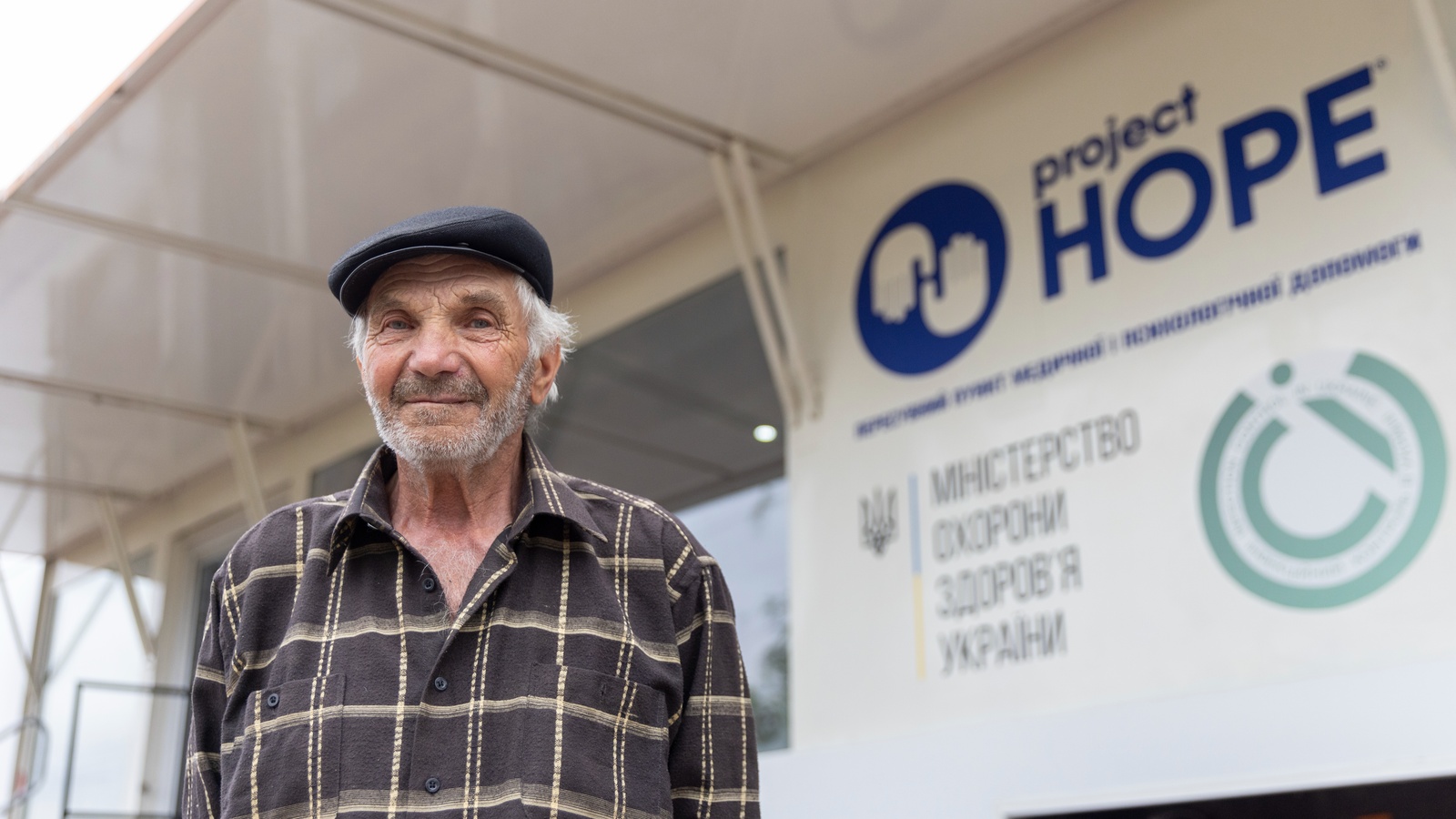
It’s been nearly a year since Russia’s invasion of Ukraine, but NAM partner Project HOPE hasn’t let up on its humanitarian aid efforts. With the generous support of many NAM members, it has helped tens of thousands of people who have seen their lives torn apart by the conflict.
What’s going on: Project HOPE—the global health and humanitarian aid organization on the ground providing relief in Ukraine and supporting refugees in Poland, Romania and Moldova—is delivering millions of dollars in medicines, medical supplies, trauma care training, mental health assistance and more to those in need.
What’s been accomplished: To date, the humanitarian relief organization has:
- Delivered 24 generators to health facilities and 34,000 hygiene kits and nonfood items in Ukraine;
- Launched 10 mobile medical units that have treated more than 35,000 patients in Eastern Europe;
- Partnered with 13 local organizations in Eastern Europe to support emergency response;
- Helped provide medical care to more than 5,800 Ukrainian refugee children in Poland;
- Provided nine child playrooms in Moldova that have provided services to more than 3,750 Ukrainian refugee children; and
- Donated more than 300 wheelchairs and other mobility equipment to refugees and others living with disabilities in Romania and Ukraine.
Helping those in need: “Manufacturers are committed to giving back: saving lives, protecting communities and responding quickly in times of trouble,” said NAM Emergency Response Committee Co-Chair and Senior Director of International Trade and Regulatory Affairs Ryan Ong.
- “That includes efforts to stand with the people of Ukraine through strong support to those providing badly needed help in the region. That’s why we’ve been pleased to support and partner with Project HOPE, which is making a difference on the ground.”
The last word: “We are so grateful for the support of the NAM community who has been an integral partner in our Ukraine response,” said Project HOPE Executive Vice President of Global Health Chris Skopec.
- “As we approach the one-year anniversary of the Russian invasion of Ukraine, we at Project HOPE remain committed to continuing to deliver medicines, medical supplies, mental health support and other urgent assistance for the people of Ukraine.”
Get involved: If you’d like to donate to those in need in Ukraine and the region, you can do so via the NAM’s partnership with Project HOPE. For more information about NAM efforts or to share what your company is doing, contact the NAM Emergency Response Committee at [email protected].
Sargento Makes a 10-Year-Old Boy’s Wish Come True
On Dec. 21, 2021, the Ball family from Winston-Salem, North Carolina, received devastating news: their son Maxx had Ewing sarcoma, a rare form of bone cancer that typically occurs in children and young adults.
Maxx’s wish: As he battled the potentially life-threatening disease, 10-year-old Maxx, whose cancer is now in remission, had one wish: to travel to Wisconsin to learn about the cheese-making process.
- “Most kids choose Disney World or a trip to Hawaii, but not my son,” said his mom Lauren. “He loves cheese and all things dairy, so he wanted to come to Wisconsin.”
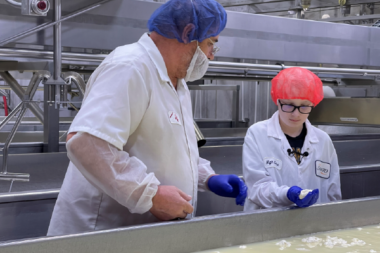
From wish to reality: The Make-A-Wish Foundation contacted Plymouth, Wisconsin–based Sargento—a leading manufacturer of shredded, sliced and snack natural cheese products—which was thrilled to grant Maxx’s wish.
Sargento has been a longtime supporter of the Make-A-Wish Foundation, partnering with other local businesses on an annual golf-related fundraiser that provides substantial support for Make-A-Wish Wisconsin. Sargento’s Executive Vice President of Operations and third-generation family owner, Mike McEvoy, has also served on the board of Make-A-Wish Wisconsin.
The itinerary: After arriving in Madison the Friday before Thanksgiving, Maxx and his family visited the Center for Dairy Research at the University of Wisconsin–Madison. He also met Wisconsin Gov. Tony Evers, visited
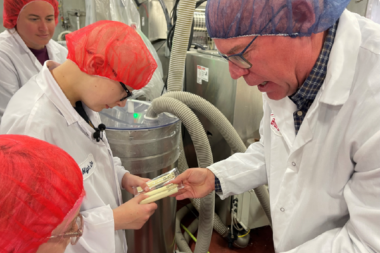
the Wisconsin State Capitol building, checked out the House on the Rock and then traveled to Green Bay to tour Lambeau Field. But the final day of his Dairyland tour was a stop at Sargento’s new location: Baker Cheese in St. Cloud, Wisconsin.
The visit: Sargento General Manager Brian Baker and Master Cheese Maker Jeff LeBeau provided a tour of the facility and explained the cheese-making process in detail. Maxx helped with making cheese curds, learned the documentation process and even operated one of the facility’s computer systems.
- “On our tour, he kept saying, ‘This is awesome,’” said Baker. ‘It really put Thanksgiving into perspective. They are a wonderful family, and what he’s gone through, to be here and to be so engaged and on the other side of his diagnosis, shows what’s really important.’”
The last word: “It was a great day, and it was a pleasure to help make Maxx’s wish come true,” said Sargento Vice President of Human Resources and Community Relations Karen Lepisto.
Dr. Ashish Jha on the Next Phase of Pandemic Response
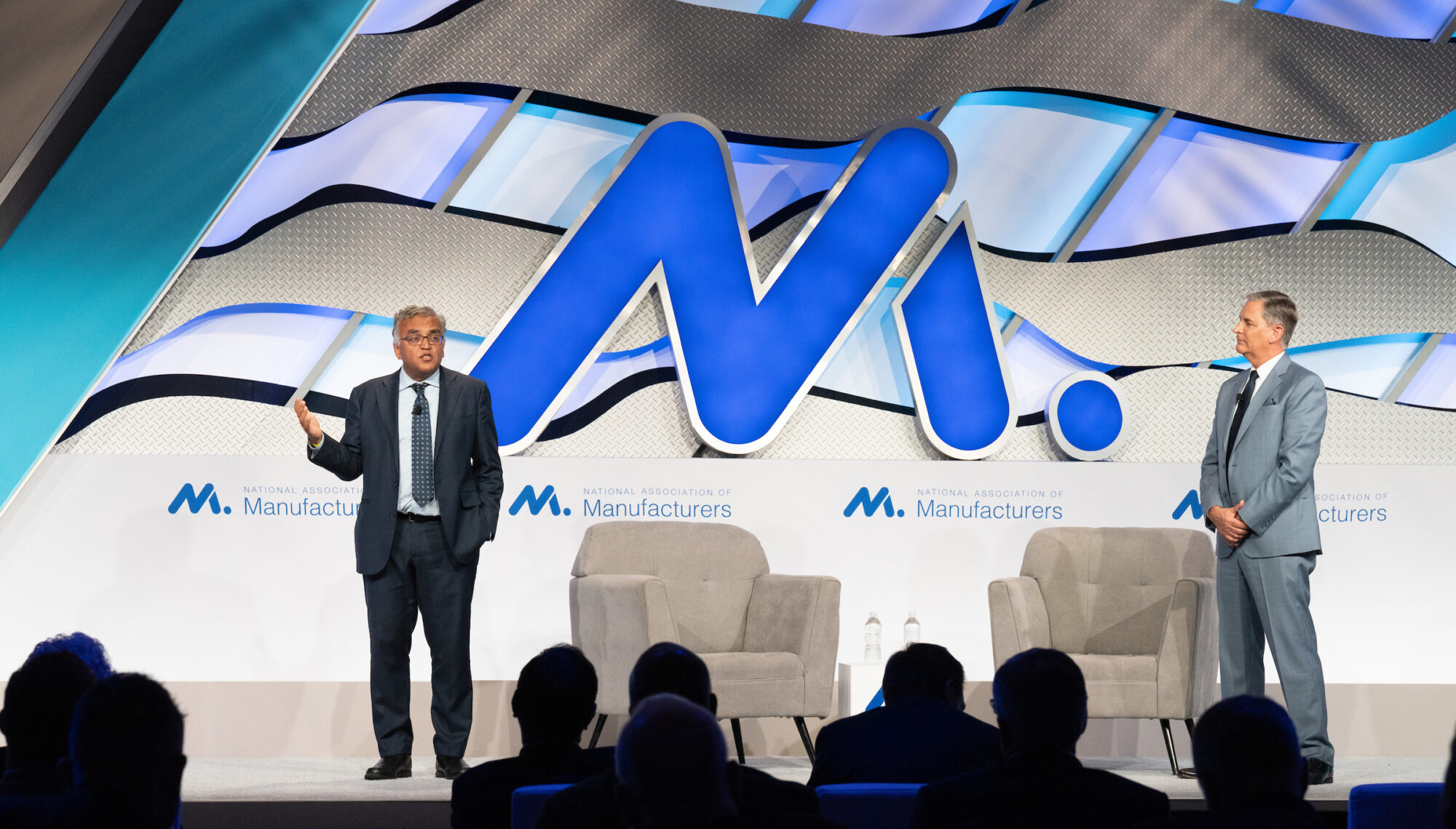
This winter, we might be facing both a difficult flu season and another surge of COVID-19. How can manufacturers help protect workers and all Americans from illness, hospitalization or worse? Dr. Ashish Jha, the White House COVID-19 response coordinator, gave a comprehensive answer at an NAM gathering of manufacturing leaders last week. Here’s what he had to say.
The situation today: Though both COVID-19 infections and deaths are down, Jha noted that if we keep steady at today’s numbers, we’ll be seeing 100,000 to 150,000 deaths per year—three to five times worse than the average flu season.
- However, “almost every one of those deaths is preventable,” he emphasized. In fact, we are better able to fight COVID-19 than the flu, as we have more effective treatments for the former.
- If we take some proactive measures, Jha added, we can “drive the death number down 90%.”
What to expect: The near future is rather worrying, according to Jha. The combination of COVID-19 and flu stands to hit us hard this winter.
- We’ve had two seasons in a row with “little to no flu”—in large part thanks to COVID-19 mitigation measures like masking and avoiding large gatherings.
- This year, however, people have largely stopped masking and are back to congregating in person. And there is reason to expect a COVID-19 wave anyway, as infections spiked during both the past two winters.
- Meanwhile, there are alarming indications that this flu season will be harsh. Jha noted that public health officials watch the southern hemisphere during our summer (their winter) to see what our flu season may be like—and this year, the southern hemisphere had an “early and robust flu season.”
- In addition, the health care workforce is truly exhausted after more than two years of the pandemic. “There’s no question that this is potentially challenging,” Jha concluded.
What to do: As alarming as the situation might be, Jha says there is “good news” as well. “We can actually control and prevent a large chunk of what might be coming down the path,” he said, as long as we focus on three key measures.
Vaccines: This is the big one. Getting people vaccinated against COVID-19 and flu is essential, said Jha, and the new BA.5-specific COVID-19 shots will make a big difference.
- The U.S. is the first country to authorize such a shot, and that means we now have a “vaccine that exactly matches the dominant variant” and that offers much better protection for today’s environment than the original vaccines.
- Jha praised manufacturers’ and the NAM’s efforts to encourage workers to get vaccinated and urged manufacturers to continue their efforts this season, including by offering paid time off for workers getting vaccinated.
Treatment: The second essential element is treatment. As Jha explained, we have very effective treatments for COVID-19, including antivirals and monoclonal antibodies. We must make sure that people have easy access to them, via test-and-treat sites and telehealth, for example. Employers can also help workers get these lifesaving treatments, he added.
- These medicines not only prevent hospitalizations and deaths, but also help people “clear the infection faster, so they feel better faster.”
- “There is some preliminary evidence that they also prevent long-term complications like long COVID as well,” Jha added.
Air quality: Last, Jha cited the importance of improving air quality to combat all respiratory infections, whether COVID-19, influenza or RSV (a common respiratory virus).
- Most Americans spend 90% of their time indoors, but don’t really think about the quality of the air they’re breathing, he noted.
- Yet, that air quality helps determine your likelihood of getting sick, and even “makes a difference to your cognition,” he pointed out. Research shows that improving air quality raised students’ test scores in schools and reduced worker absences.
- We can improve indoor air quality by upgrading filters, improving air exchanges with the outdoors or using air purifiers, he advised.
The long term: “The virus will continue evolving, and that means we need a long-term strategy for building people’s immunity,” said Jha.
- The next generation of vaccines—including nasal vaccines that block transmission and “variant-proof” vaccines—will truly put COVID-19 behind us. And we need to develop these vaccines fast, via a partnership between the government and private sector, he said.
- Improving indoor air quality will also have a huge long-term impact, he added, as the economy loses tens of millions of dollars from worker absences due to illness.
- “We should use this moment, with all that we have learned from this pandemic, to build a healthier society,” he said.
The last word: In conclusion, Jha said, “Let me wrap up by saying thank you for the incredible leadership so many of you have shown in bringing our country as far forward as it has come.”
- “This next set of challenges is every bit as big as the original,” he warned. Yet, when the public and private sector work together, they “can accomplish enormous things,” like the development and deployment of the COVID-19 vaccines.
- “My hope is that we can continue doing that work together. And if we do, we can certainly get through this fall and winter without disruption, without a lot more sickness . . . and get our country to a much better, healthier and more productive place.”
Manufacturers: Lawmakers Who Support Manufacturing in America Should Oppose This Reconciliation Bill
Washington, D.C. – Following news of a potential reconciliation agreement among Senate Democrats, National Association of Manufacturers President and CEO Jay Timmons released the following statement:
“This proposal is nothing more than a repackaging of the same bad ideas with a new name slapped on it. It is especially harmful because it will undermine manufacturers’ competitiveness at a time when the industry is reeling from supply chain disruptions and record inflation. Manufacturers kept our promises after the 2017 tax reforms, hiring more workers, investing in our communities and raising wages and benefits. Raising taxes now will hurt manufacturers’ ability to keep delivering for our people and mean fewer opportunities for Americans already worried about their financial future.
“Government price controls on pharmaceutical manufacturers are no less destructive. They will weaken our ongoing work to develop lifesaving cures to complex diseases like cancer and Alzheimer’s and harm our responses to health crises. It’s bad for Americans’ health. It’s wrong for our economy.
“While the language purportedly calls for comprehensive permitting reform to be passed by the end of the fiscal year, there is nothing that prohibits Congress from doing exactly that right now. Any member of Congress who is voting for the bill based solely on that language should not do so and should instead push to have a standalone bill considered.
“Lawmakers who support manufacturing in America should oppose this reconciliation bill. It will make manufacturing less competitive and America economically weaker.”
-NAM-
The National Association of Manufacturers is the largest manufacturing association in the United States, representing small and large manufacturers in every industrial sector and in all 50 states. Manufacturing employs more than 12.8 million men and women, contributes $2.77 trillion to the U.S. economy annually and accounts for 58% of private-sector research and development. The NAM is the powerful voice of the manufacturing community and the leading advocate for a policy agenda that helps manufacturers compete in the global economy and create jobs across the United States. For more information about the NAM or to follow us on Twitter and Facebook, please visit www.nam.org.
NAM Launches Six-Figure Television Ad Campaign Opposing Reconciliation
NAM Urges Senate to Vote “No” on Government Price Controls That Harm Manufacturers
Washington, D.C. – The National Association of Manufacturers has launched a six-figure broadcast and cable television advertising campaign ahead of a potential reconciliation bill that threatens manufacturing innovation and competitiveness. The campaign calls on senators to oppose government price controls that would undermine the development of lifesaving medicines and the livelihoods of manufacturing workers across America who deliver them.
“Government price-setting schemes that undermine our ongoing work to develop lifesaving cures to diseases like cancer and Alzheimer’s and respond to health crises are never the answer,” said NAM President and CEO Jay Timmons. “At a time when manufacturers are already facing extraordinary economic pressures, the Senate should be focused on bolstering our industry’s competitiveness, not undermining it. We are calling on senators to vote ‘no’ on reconciliation and stand with manufacturers and the hardworking Americans who are integral to battling this pandemic and discovering future cures.”
To view the latest television ad, click here.
-NAM-
The National Association of Manufacturers is the largest manufacturing association in the United States, representing small and large manufacturers in every industrial sector and in all 50 states. Manufacturing employs more than 12.8 million men and women, contributes $2.77 trillion to the U.S. economy annually and accounts for 58% of private-sector research and development. The NAM is the powerful voice of the manufacturing community and the leading advocate for a policy agenda that helps manufacturers compete in the global economy and create jobs across the United States. For more information about the NAM or to follow us on Twitter and Facebook, please visit www.nam.org.
Manufacturers Support Health Insurance for Older Workers
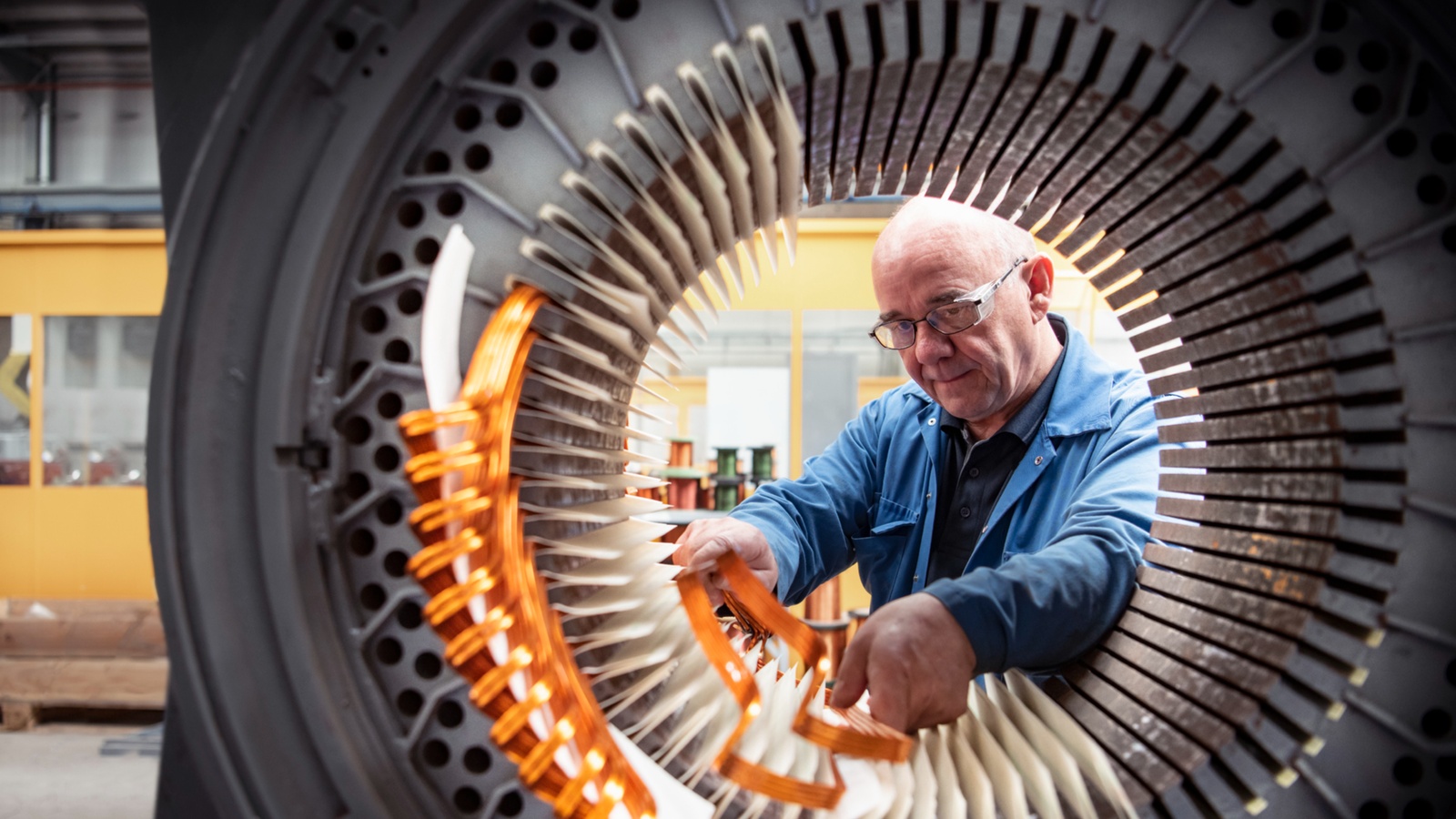
As the manufacturing industry continues to grow, manufacturers across the country are ensuring that older workers and company retirees have the support they need—including through health care options like Medicare Advantage.
What it is: Medicare Advantage Plans are offered by private insurance companies that have been approved by Medicare. They provide the same hospital and medical insurance as original Medicare, but with additional benefits—often including Part D prescription drug coverage, as well as vision, dental and hearing services. Medicare Advantage Plans also include a maximum out-of-pocket spending limit to offer additional protection.
- Medicare Advantage beneficiaries spend 40% less annually than those enrolled in Medicare Fee-for-Service, while also experiencing a 43% lower rate of avoidable hospitalizations for preventable complications, according to UnitedHealth Group.
- Employers have been able to take advantage of this health care model for retirees by offering what is known as Employer Group Waiver Plans.
Why it matters: Attracting and retaining a quality workforce is one of the most important challenges facing the manufacturing industry, especially as the industry confronts a labor shortage. Affordable and competitive health care benefits are one of many retention tools utilized by manufacturers.
- In 2021, 25.6% of the manufacturing industry’s workforce were 55 or older, while 5.3% were over 65, according to data from the Bureau of Labor Statistics.
- According to the NAM’s latest Manufacturers’ Outlook Survey, 80.7% of manufacturers cited the inability to attract and retain a quality workforce as a primary business challenge.
- The high-quality options provided by Medicare Advantage allow manufacturers to retain their older workers and keep them happy and healthy in their jobs.
What we’re saying: “Ninety-five percent of manufacturing employees were eligible for health insurance benefits in 2020, according to the Kaiser Family Foundation, while 99% of NAM members offer health benefits. Manufacturers are supportive of flexibility, expanding coverage options and enabling innovative models of care to maintain a healthy workforce and provide competitive benefits,” said NAM Director of Human Resources and Innovation Policy Julia Bogue.
For details on other ways manufacturers can retain older employees check out insights from the Manufacturing Institute and AARP here.
NAM Outlines Health Care Priorities

In a message to members of the Congressional Health Care Task Force, NAM President and CEO Jay Timmons urged Congress to pursue several health care priorities for manufacturers.
The big picture: Timmons laid out three core principles that guide NAM health care advocacy and engagement.
- First, the NAM believes that free enterprise, competitiveness, individual liberty and equal opportunity are the values that can successfully push forward the process of simplifying health care and achieving lower costs.
- Second, the NAM believes that the medical credo “first, do no harm” should guide health care policy efforts.
- Third, the NAM believes that the health care policy and business environment must allow and encourage unparalleled innovation, investment and manufacturing right here in the U.S.
In accordance with these principles, the NAM is pushing for several specific policy advances.
Transparency: “Manufacturers appreciate ongoing efforts to improve transparency in health care,” Timmons wrote. “Our industry has experienced the impacts of cost variation related to a range of health care services. These impacts can make health coverage more frustrating and expensive, for both consumers and employers who sponsor coverage.”
Connectivity: “The technology is available, and businesses have the capability to deliver and realize the potential of a fully connected health care system,” Timmons wrote. “Privacy laws and regulations need updating so that the deployment and adoption of new innovations to improve connectivity in our health care system can flourish.”
HSAs: The NAM believes Health Savings Accounts allow employees to have more control over their health care spending. To ensure HSAs can increase consumer flexibility and benefit American employees, the NAM supports efforts to increase limits and modernize rules governing HSAs.
Value-based arrangements: “Manufacturers are encouraged by the potential for health care innovation through outcomes-based health care arrangements,” Timmons wrote. “These arrangements would align incentives across a range of parties—health care providers, employers, patients, insurers and pharmaceutical and life sciences manufacturers—so that delivery of care, payment arrangements and clinical outcomes are achieved in an efficient manner.”
Association health plans: The NAM supports efforts to reform, advance and strengthen Association Health Plans. AHPs are beneficial especially to small businesses that struggle to offer affordable health care coverage to their employees. The NAM believes that additional legislation is needed to protect the longevity and sustainability of AHPs as a health care option.
Innovation: The NAM believes strong intellectual property protection is essential to creating a more competitive health care market, bringing down prices and fostering innovation by encouraging research and development.
The last word: “Despite the many challenges and strains facing the health care system, we are a nation that prides itself on first-class, best-in-the-world medical care,” Timmons wrote. “Our institutions, public and private, continue to lead the world on patient care, lifesaving treatments and medical research. We must uphold those successes while seeking to control or lower the cost of health care through market-oriented approaches. Employers are leading a great deal of innovation in health care delivery, and those positive developments must be allowed to flourish.”
Manufacturers on Supreme Court Decision
Washington, D.C. – National Association of Manufacturers President and CEO Jay Timmons released this statement following the Supreme Court’s ruling in Dobbs v. Jackson Women’s Health Organization:
“America is at its best when we address difficult questions in a spirit of compassion and empathy, with respect for each other’s deeply held views. That is the example that we will strive to set at the NAM. Our mission is to uphold the values of free enterprise, competitiveness, individual liberty and equal opportunity, which we know have made America exceptional and kept manufacturing strong.
Even amid all positions and strongly held views, many businesses must now discern how best to support employees and families within the framework of the law. The NAM will work to connect our member companies with the legal, HR and health care information and resources they need to navigate the effects of the ruling.”
-NAM-
The National Association of Manufacturers is the largest manufacturing association in the United States, representing small and large manufacturers in every industrial sector and in all 50 states. Manufacturing employs more than 12.7 million men and women, contributes $2.71 trillion to the U.S. economy annually and accounts for 58% of private-sector research and development. The NAM is the powerful voice of the manufacturing community and the leading advocate for a policy agenda that helps manufacturers compete in the global economy and create jobs across the United States. For more information about the NAM or to follow us on Twitter and Facebook, please visit www.nam.org.
